





Vietnam, 1972: A-1H Skyraiders of the USAF 1st Special Operations Squadron ride herd on a Sikorsky HH-3E “Jolly Green Giant” conducting a combat search and rescue.
Nicknamed for a wood-and-wire WWI fighter, the A-1 Skyraider was a prop-spinning relic in the jet age. But over Vietnam it flew missions that no jet could
|
AS SEEN in the August 2017 issue of VIETNAM magazine 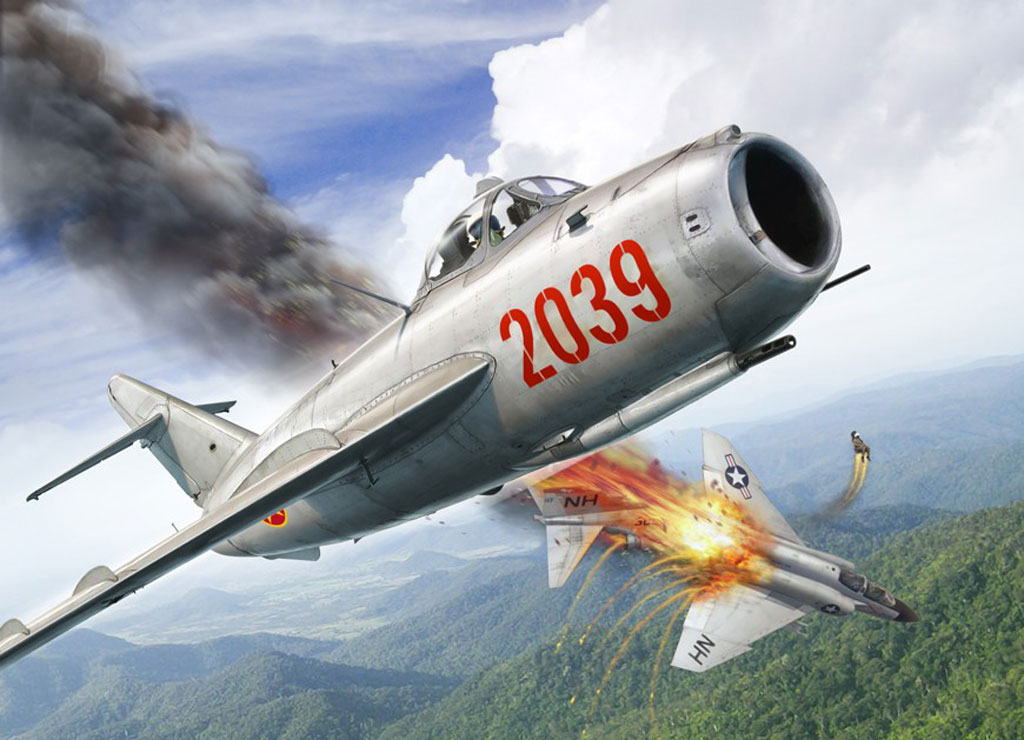
MiG-17 “Fresco” vs. F-4 Phantom. Early-war Phantoms did not even carry guns. Artist unknown. March 8, 1965: 9th Marine Expeditionary Brigade lands at Danang to an amused welcome by locals. (Silent) Three and a half months after the first US Marines waded ashore unopposed at Da Nang, Vietnam, American jet pilots learned they wouldn't have it so easy. On June 20, 1965, the first USAF F-4C Phantom fell to a MiG-17 “Fresco” near Ta Chan, in northwest North Vietnam. Anticipating a force of America's newest, most advanced combat aircraft to rescue its crew, two Fresco pilots of the North Vietnamese 921st Fighter Regiment instead met ghosts out of the past: four gleaming white, straight-winged prop planes, Douglas A-1 Skyraiders of US Navy attack squadron VA-25, “The Fist of the Fleet.” “At 12,000 feet and 170 knots we looked like Tweetybird to Sylvester the Cat,” remembered second-section leader Lt Clinton B. Johnson of spotting the enemy jets. “Our only hope was to get down low and try to out turn the MiGs.” 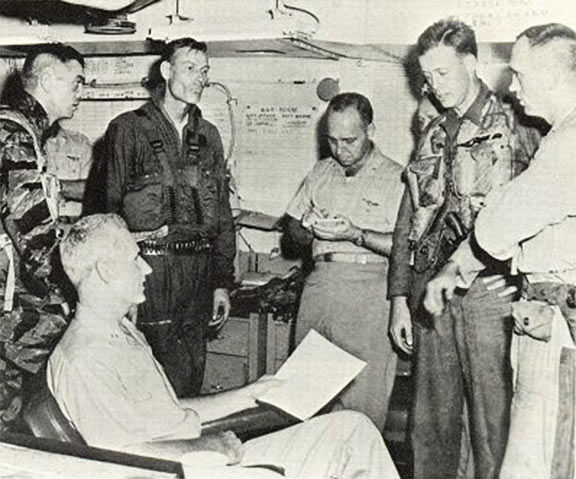
VA-25 pilots debrief, June 20 1965. L-R: LTJG Charles Hartman (#4 in formation), LCDR Ed Greathouse (#1), LT Clint Johnson (#3), LTJG Jim Lynne (#2). Seated: RADM William F. Bringle Following him down into the weeds, wingman Lt(jg) Charlie Hartman worried, “The familiar story of the No. 4 man being the first to be downed raced through my mind.” “A silver MiG-17 with red marking on wings and tail streaked by Charlie and me,” reported Johnson. “…Tracers from behind and a jet intake growing larger in my mirror were a signal to start pulling and turning….[The second MiG] was unable to stay inside our turn and overshot.” But the first MiG had gone after the lead pair of Skyraiders. “I caught a glimpse of the leader and his wingman and headed for them,” recalled Johnson. “As we had been flying at treetop level in and out of small valleys, we had to fly around a small hill to get to them. Coming around the hill we saw…the MiG lined up behind them….He turned hard into us to make a head-on pass.” But that gave Johnson and Hartman a head-on shot too. “We both fired our cannons,” Hartman said. Eight 20 mm guns—about 140 explosive shells all told—were fired at the North Vietnamese plane. “I saw the MiG’s canopy shatter,” Hartman said. The MiG had passed so close, Johnson recalled, “that Charlie thought that I had hit his vertical stabilizer with the tip of my tail hook and Charlie flew through his wake….He never returned our fire, rolled inverted and hit a small hill exploding and burning in a farm field.” The venerable Skyraider had its first “kill” of the Vietnam War. One of the Phantom crewmen was taken prisoner, and the other was rescued by helicopter the next day. 
Lt Clinton B. Johnson and Lt(jg) Charlie Hartmann of US Navy attack squadron VA-25 tackle a MiG-17 “Fresco” head-on. Artist unknown. 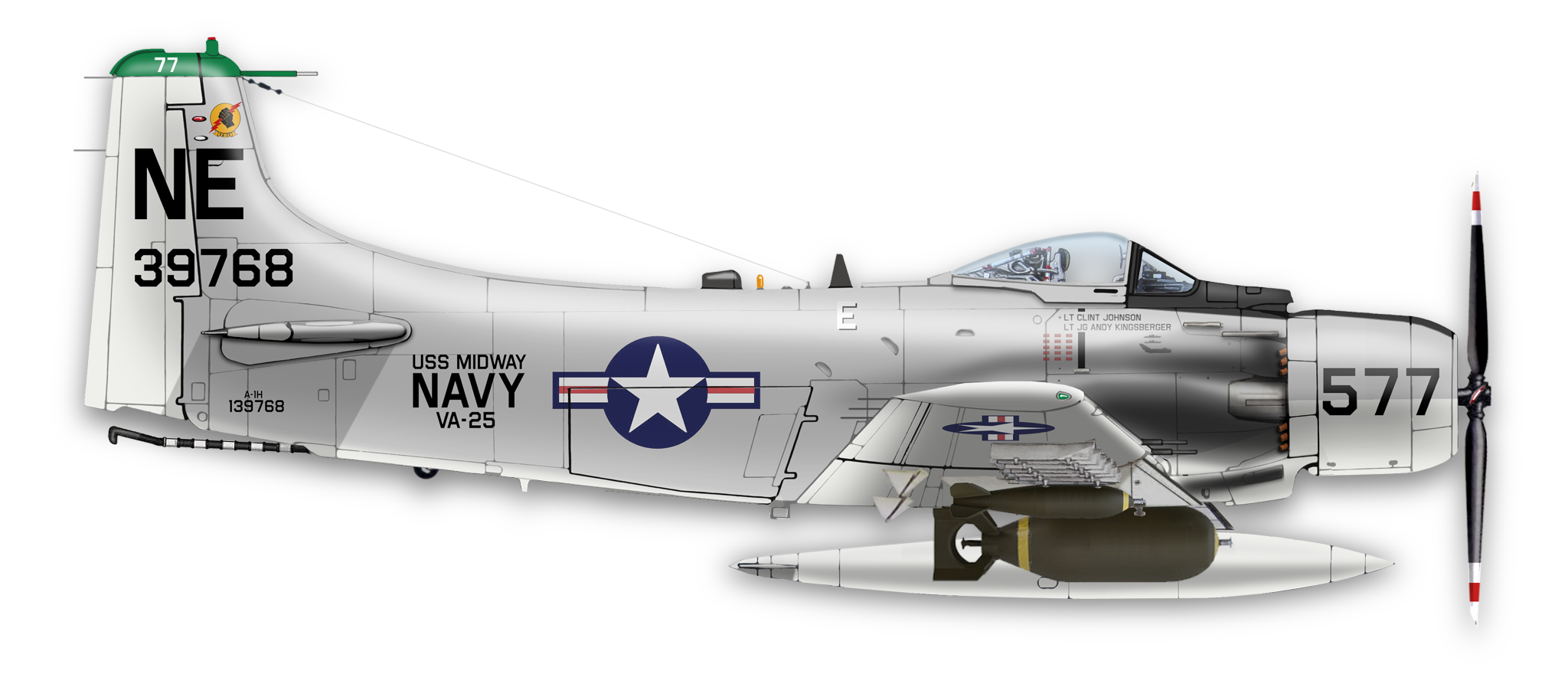
On June 20, 1965, this A-1H of Navy attack squadron VA-25 shared in the war’s first aerial gunnery kill of a MiG-17. At that point in the war, Skyraiders were still dropping WWII-vintage high-drag bombs. The prototype XSB2D Destroyer first flew on 8 April 1943. It was much faster than the frontline Curtiss SB2C Helldiver and carried nearly double its weapons load. The U.S. Navy, however, wanted its future carrier-based torpedo/dive bombers to have single-seats and no defensive rear turrets. The resulting BTD-1 Destroyer flew on 5 March 1944 and the first production models were ready in June 1944 when the Navy changed its requirements again. Only 28 Destroyers were delivered. None ever saw combat. 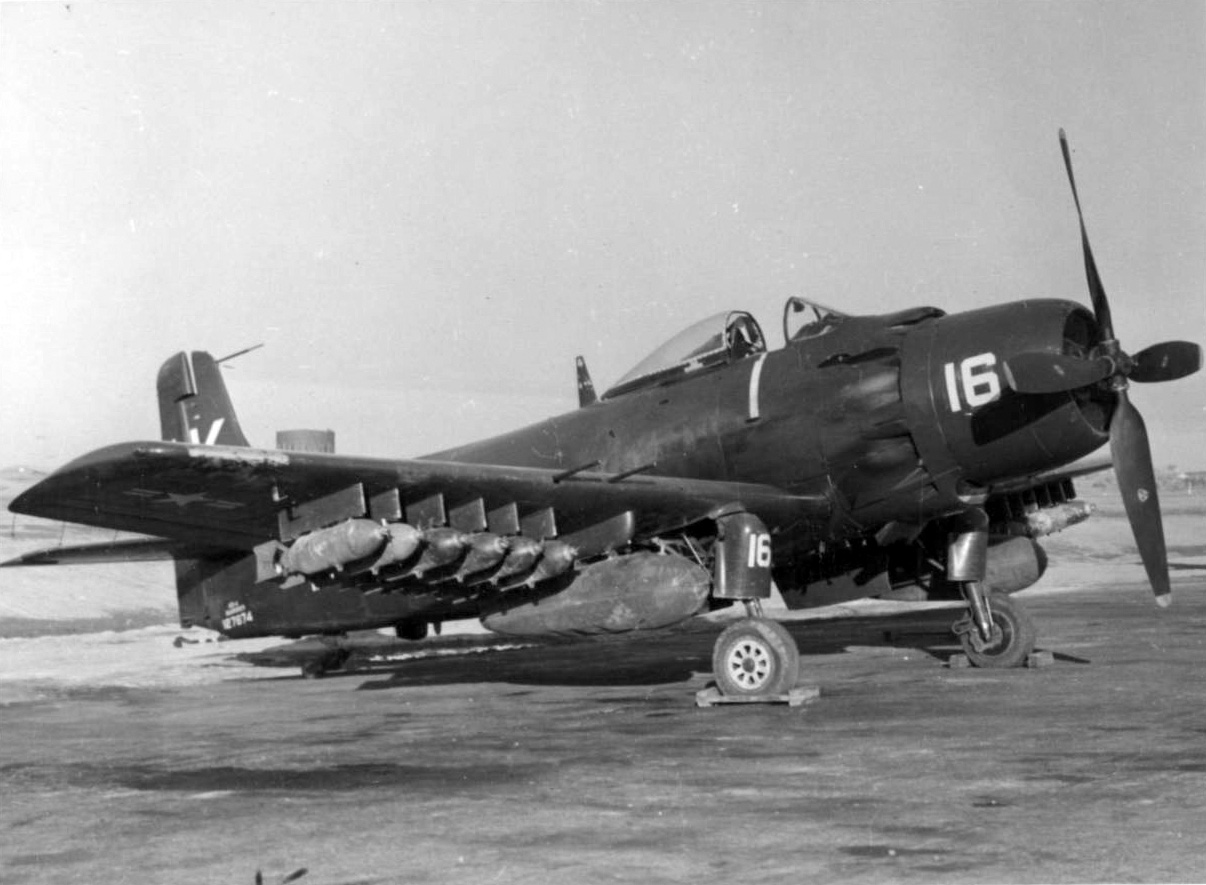
U.S. Marine Corps Douglas AD-4 Skyraider #127874 of VMF-121 at airfield K-6, Pyongtaek, South Korea, 1952. 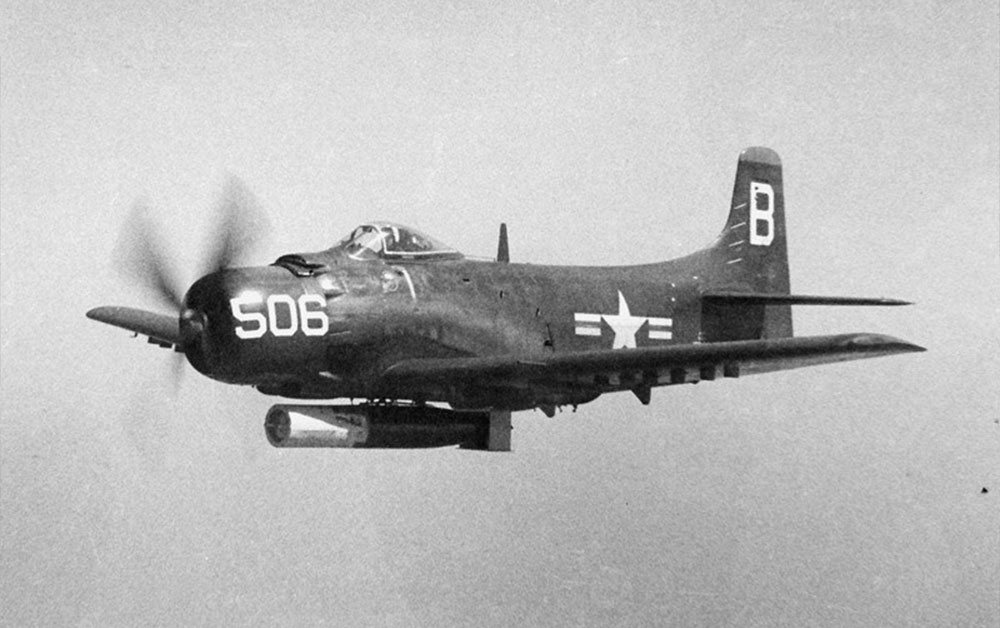
AD-4 Skyraider of VA-195 on Hwachon Dam mission, 1951. A plywood “drag ring” around the torpedo’s nose will slow its entry into the water; plywood shielding around the tail will break away on impact The North Vietnamese pilots called the bare-metal, swept-wing MiG the “Silver Swallow.” U.S. pilots nicknamed the A-1 Skyraider “Spad,” after a wood-and-wire World War I fighter. By June 1965 the Skyraider was a 20-year-old design. In those two decades, fighter planes had gone from pistons to turbines, from a few hundred miles per hour to over Mach 2. The Skyraider was conceived in June 1944 when Navy planners rejected Douglas Aircraft Co. chief engineer Ed Heinemann’s concept for a dive/torpedo bomber. They wanted a single-seater designed around the huge twin-bank, 18-cylinder, 2,500-horsepower Wright R-3350 Duplex-Cyclone radial engine used in the Boeing B-29 Superfortress bomber. Up against deadline, Heinemann and his staff famously pulled an all-nighter and put drawings on Navy desks in the morning. Too late for World War II, their A-1 Skyraider—the last tail-wheeled airplane in the Navy inventory—was the world’s biggest, most powerful prop-driven, single-seat combat aircraft, able to lift truly freakish weapons loads, greater than that of a Boeing B-17 Flying Fortress. (In May 1953 a Skyraider in Dallas took off with fuel and ordnance totaling almost 27,000 pounds, comparable to a twin-engine Douglas C-47 transport plane packing two dozen troops.) 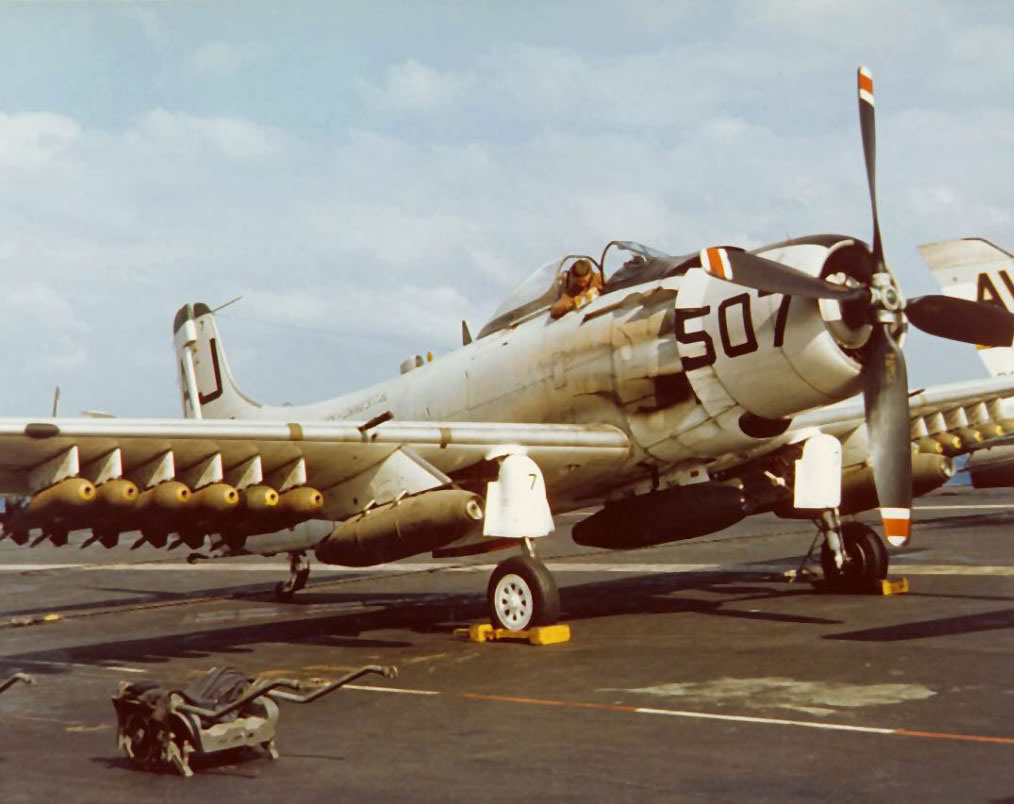
VA-85 Skyraider on the deck of CVA-59 USS Forrestal for firepower demonstration for President John F. Kennedy, April 1962. In 1955 Navy aircraft camouflage changed from midnight blue to light "gull gray" on upper surfaces with white undersides.
Over Korea the Skyraider flew missions that no contemporary jet could. A Grumman F9F Panther jet could only stay aloft for an hour and a half, and carry just six rockets and a couple 1,000lb bombs. Meanwhile, with all that horsepower and 15 underwing hardpoints the “Flying Dump Truck” could pack its own weight in bombs: a 2,000-pounder on the centerline, a 1,000-pounder on each inboard pylon, and up to twelve 250-pounders under the wings. If bombs weren't enough, it could launch everything from 2.75-inch folding-fin rockets to 5-inch HVARs and 11-inch Tiny Tims. In May 1951 Skyraiders of VA-195 even dropped torpedoes to blow a hole in North Korea's Hwacheon Dam—the last aerial torpedo attack in history. “We dropped everything on them [the North Koreans] but a kitchen sink,”
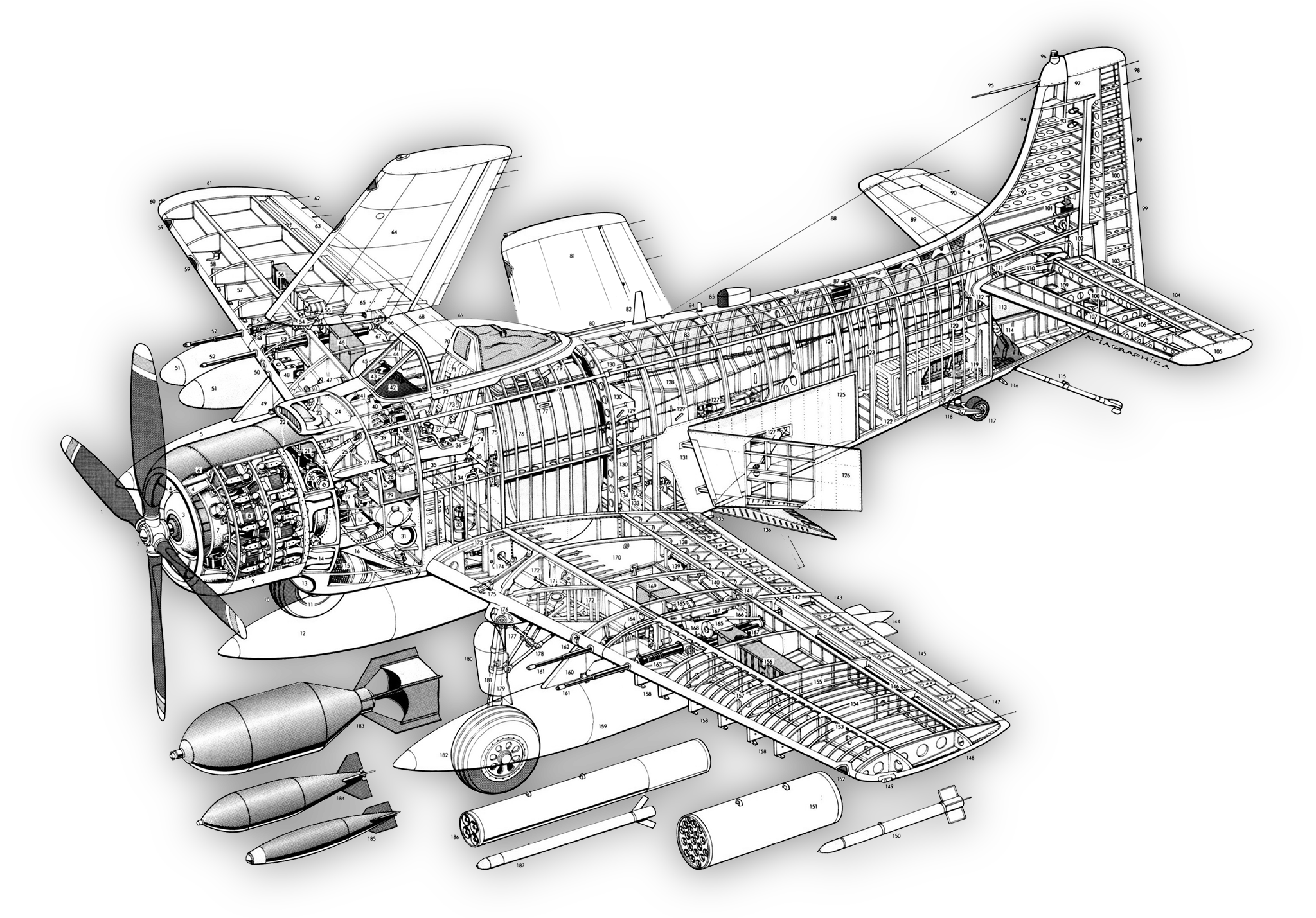
Douglas A-1H (AD-6) Skyraider
1 Aeroproducts four-bladedvariable pitchpropeller, 13ft 6in (4.1m) diameter
64 Starboard wing, folded position
129 Handgrips Former B-52 Stratofortress pilot Capt. Richard Drury called his A-1 “a time machine….It carried nearly 40 gallons of oil, most of which wound up on the aircraft surfaces and on the pilots. It also burned about 100 gallons an hour of fuel. For all that it barely went three miles a minute with an ordnance load. But speed was a relative thing and had lost all its importance in the sort of war we would be in.” Agility, not speed, would be the Skyraider’s best defense over Vietnam. 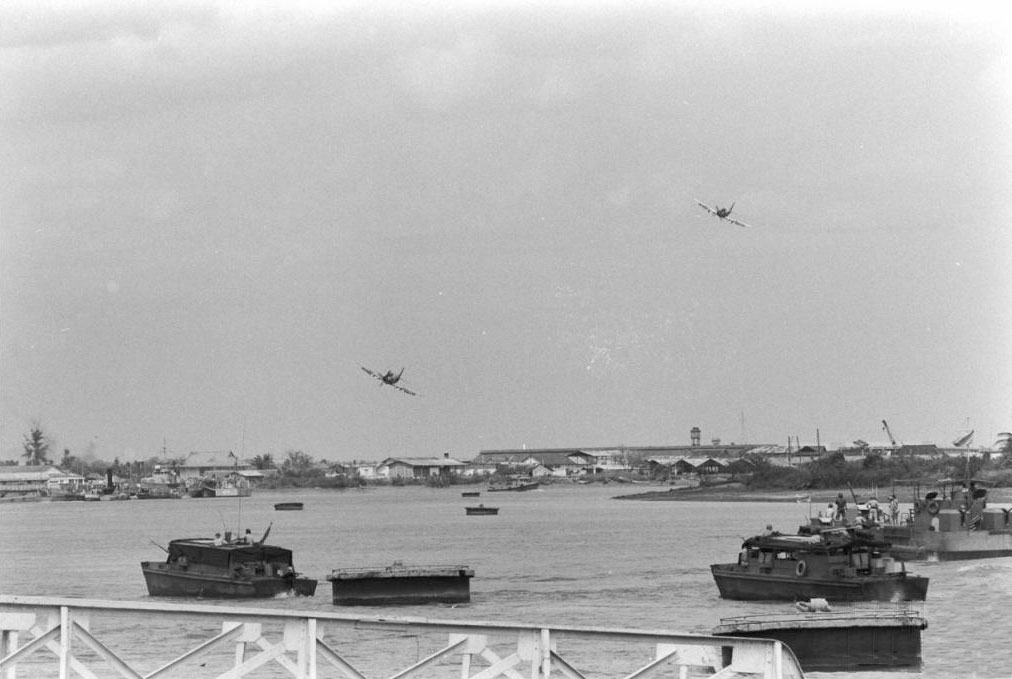
On the morning of Feb. 27, 1962, Skyraiders of VNAF Lt. Phan Phu Quoc and Lt. Nguyen Van Cu cross the Saigon River on their way to attacking Independence Palace, Saigon. More In September 1960 the Eisenhower administration saw the A-1 as the ideal combat aircraft—front-line, but no longer state-of-the-art—to bolster South Vietnam’s fledging air force. That November South Vietnamese air force Skyraiders helped put down an attempted coup. In February 1962, however, two mutinous A-1 pilots bombed and strafed the presidential palace in Saigon. The future South Vietnamese prime minister and vice president, Nguyen Cao Ky, began his rise to power as a flamboyant Spad pilot. “Never had I flown such a powerful aircraft!” he remembered of his first flight in 1964. “As I raced down the runway the Skyraider was a tiger leaping into the sky….It took all the strength of both arms and both legs to establish control. By the time I had stabilized aircraft altitude, I was at 12,000 feet….The next time I took off in an A-1, I would carry a full load of bombs to drop on the enemy.” When the U.S. Navy joined the war, Skyraiders led the way. On Aug. 5, 1964, carriers Ticonderoga and Constellation launched the first air raids into North Vietnam during Operation Pierce Arrow, in retaliation for reported torpedo boat attacks on U.S. destroyers in the Gulf of Tonkin. Lt. j.g. Richard Sather was in an A-1H, making his third pass against patrol boats of the North Vietnamese navy, when he was hit by anti-aircraft fire and crashed in the shallows of Loc Chou Harbor. Sather, who had recently written home that he would “go into battle because this was the thing to do, the thing I’ve been trained for,” was naval aviation’s first casualty in Vietnam. As the fighting intensified, the U.S. Air Force needed Spads to deliver the slow, accurate, close air support its fleeting jets could not provide. At first, bush-hatted U.S. air commando advisers shared cockpits with Vietnamese pilots in two-seat “fat face” A-1E Skyraiders with South Vietnamese air force insignia. Richard Foreman, a U.S. Air Force first lieutenant at the time, hitched a ride with a Vietnamese pilot from Tan Son Nhut Air Base in Saigon to Nha Trang, 200 miles to the northeast. “I was in the right seat,” Foreman remembered, “and in the back were five or six Vietnamese with their belongings, including a few chickens.” In February 1965, responding to Viet Cong attacks on American bases, U.S. and South Vietnamese Spads crossed the Demilitarized Zone to hit North Vietnamese Army bases near Don Hoi. Ky, by then an air vice marshal, led his A-1s against anti-aircraft emplacements. “Their return fire was ferocious,” according to Ky. “Every one of the 24 planes I was leading was hit. My own plane was struck by four bullets, one of which grazed my body as I lifted my arm in reflex to protect my face. I found that bullet and saved it for my wife. Two of my pilots were forced to bail out into the sea.” 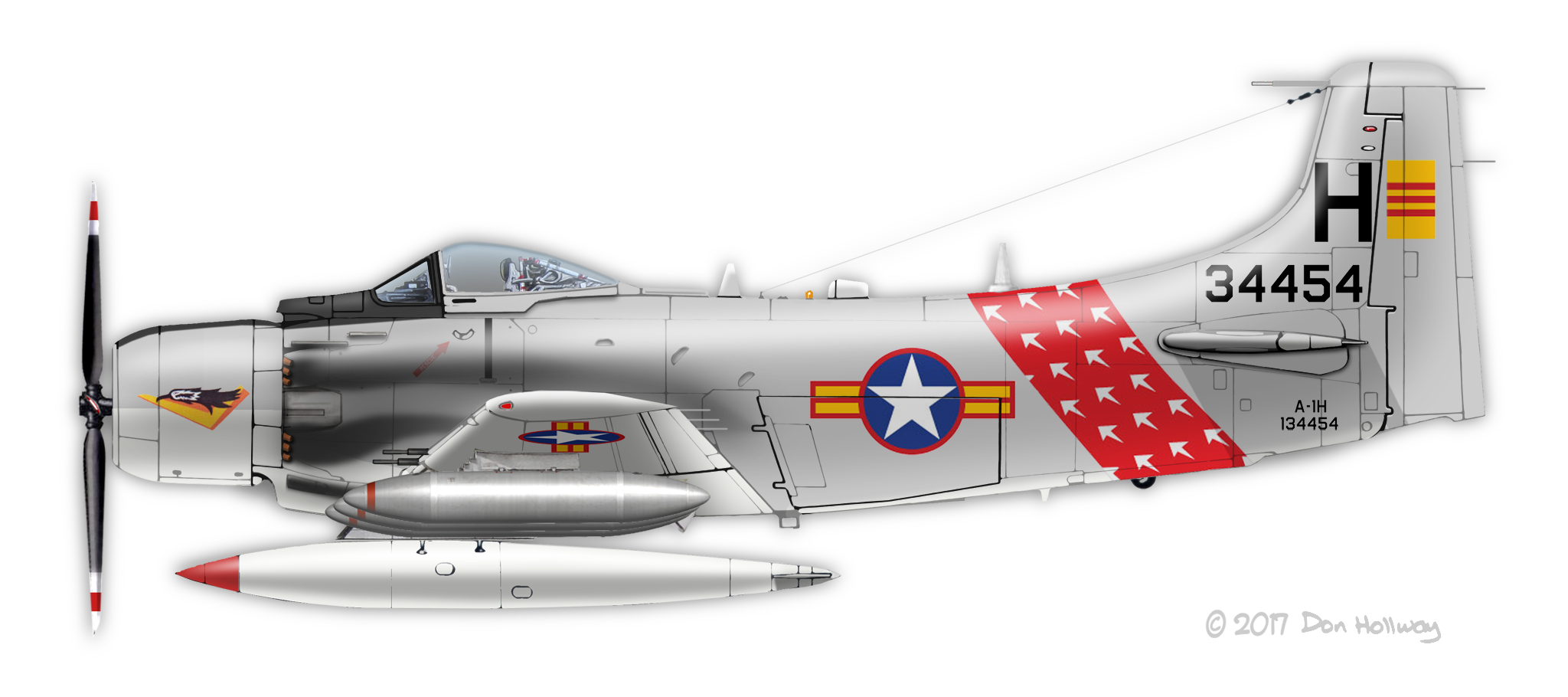
A-1H, VNAF 1st Fighter Squadron, Bien Hoa Air Base, 1965. Flown by Air Vice-Marshal Nguyen Cao Ky. Ex-US Navy Skyraiders in VNAF service had no tail hooks. 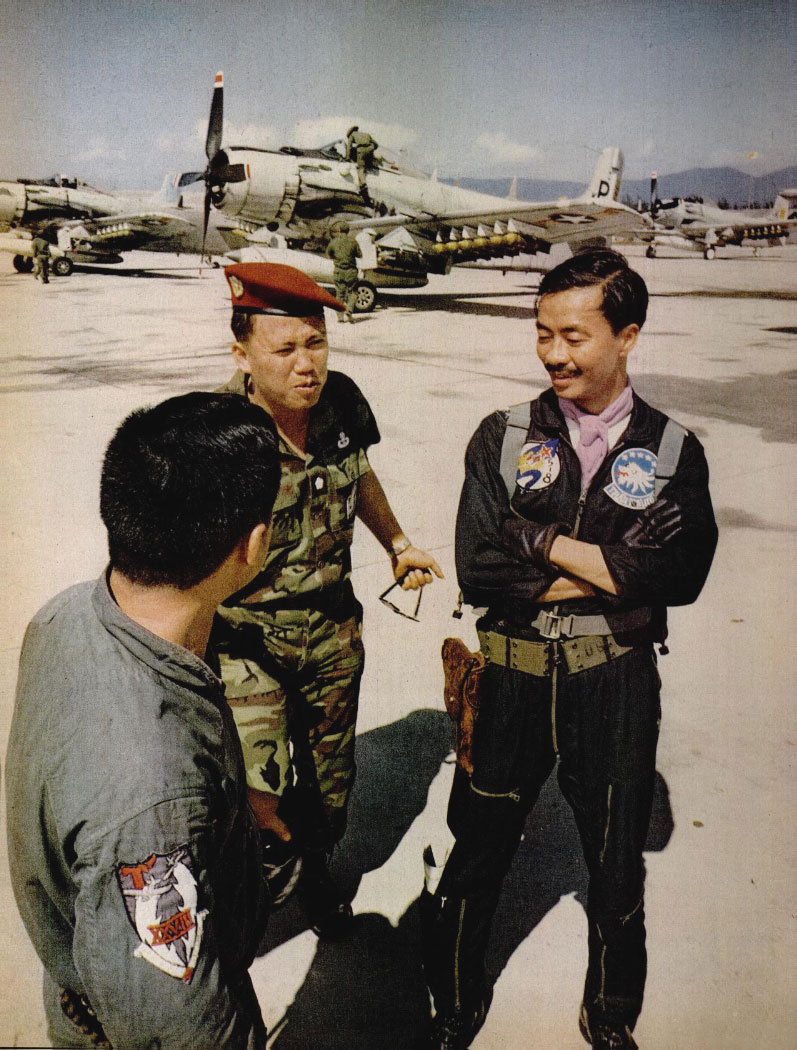
Ky (right) shares a laugh with his pilots after their first visit “up north” during Operation Flaming Dart, Feb. 1965. Less than two weeks later Ky and his A-1s proved decisive in stopping yet another coup attempt when he threatened to bomb rebels in the capital. The coup plotters decided to negotiate. “I agreed but launched two flights of Skyraiders—eight aircraft carrying 32 tons of rockets—to fly over Saigon,” Ky remembered. “Those planes could remain aloft for four or five hours. With this move I both controlled the air over the capital and would be able to quash further hostile troop movements into the city.” Ky’s Spads flew cover as loyalist troops and tanks retook control. He soon became prime minister, thanks in no small part to the Skyraider. After Ky’s Skyraiders defend the capital, he takes a controlling position in the Saigon government. Enlarge When Ky got wind of the Navy Spads’ aerial victory over Ta Chan that June, Johnson wrote, he “demanded our appearance for Vietnamese awards.” Ky told Johnson and Hartman that their MiG kill “had boosted morale tremendously” in South Vietnamese Skyraider squadrons. 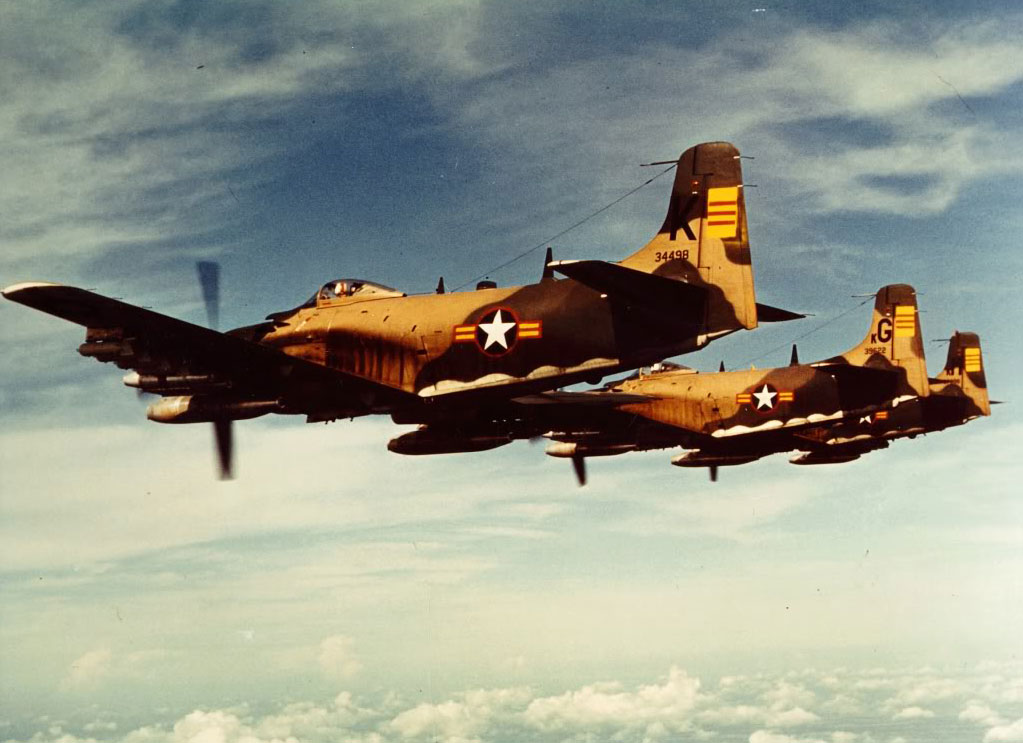
Vietnamese Air Force A-1H Skyraiders in action. The VNAF were first to camouflage their Spads. (Note middle aircraft shows slight variation in pattern.) Later in the war the national insignia was reduced in size. The big question, of course, was whether the A-1 could survive skies full of jet fighters. Over Ta Chan in June 1965, three pilots learned the answer. U.S. Navy and Air Force Skyraiders hunted truck convoys up and down the Ho Chi Minh Trail in Laos and Cambodia. “We went in at night—usually in flights of four,” according to then-Cmdr. George Carlton of attack squadron VA-215 off USS Hancock. They chose routes with minimal threats of anti-aircraft artillery. The standard combat load was four high-intensity parachute flares, 800 rounds of 20 mm ammunition, two 19-shot 2.75-inch rocket packs and a mix of four 250- and 500-pound bombs. But the Skyraiders had no onboard radar, infrared or night-vision aids. “We were limited to our ‘Mark One’ eyeballs [naked eyes] for searching and tracking,” said Carlton, who later became a Navy captain. “It was a difficult cat and mouse game at best, for at the first indication of our presence, the trucks cut their lights and headed for cover in ditches and under trees….We jokingly referred to these missions as making tooth picks the hard way.” In March 1966 more than 2,000 troops of the NVA 95th Regiment, 325th Division, came down the trail to besiege a platoon of Green Berets and several hundred South Vietnamese in the A Shau Valley, near the Laotian border. Diving into the mountains surrounding the base, one pilot said, “was like flying inside Yankee Stadium with the people in the bleachers firing at you with machine guns.” During a March 10 attack on the NVA, Skyraider pilot Maj. Dafford W. “Jump” Myers of the 602nd Fighter Squadron (Commando) radioed, “I’ve been hit and hit hard.” He crash-landed his blazing Spad on the base airstrip. With enemy troops within 20 yards of Myers’ position and the nearest rescue chopper 30 minutes out, Maj. Bernard F. “Bernie” Fisher, an A-1E pilot of the 1st Air Commando Squadron out of Pleiku, told everyone, “I’m going in.” On March 10, 1966, during the ill-fated battle to save the Special Forces camp in the A Shau Valley, Major Bernard F. Fisher, 1st Air Commando Squadron, saw fellow Skyraider pilot Major Dafford W. Myers crash-land on the airstrip. Braving enemy fire, Fisher landed his own two-seat A-1E and rescued Myers, for which he won the Medal of Honor. 
U.S. Navy AD-5 Skyraider Bu. No. 132649, authorized in 1952, became USAF A-1E 52-132649. (The AD series was redesignated A-1 in 1962.) A-1E, 52-132649 of the 1st Air Commando Squadron was flown by Major Fisher on his Medal of Honor-winning rescue of Maj Dafford “Jump” Myers. 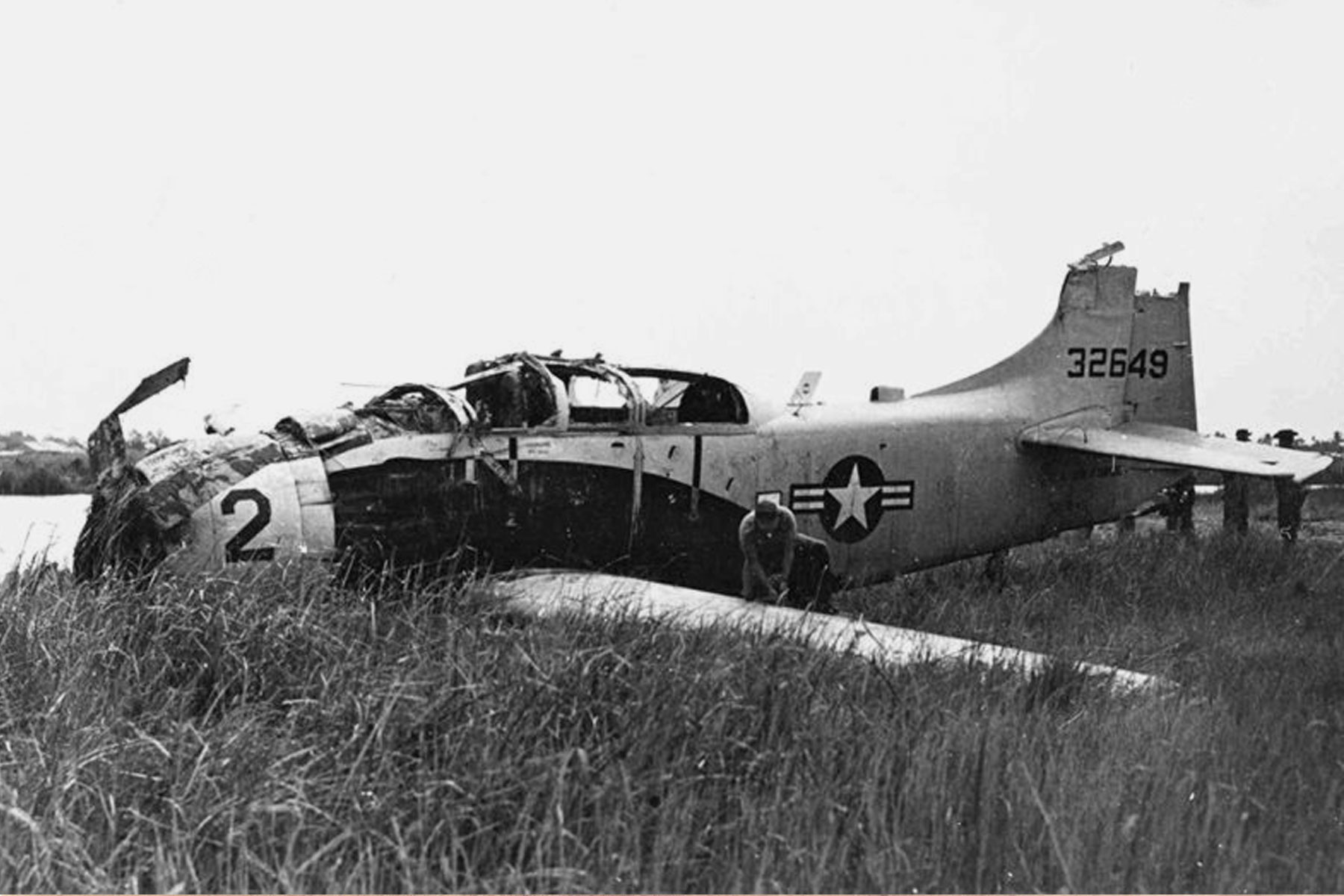
Prior to Fisher’s exploit, on Mar 21, 1965 52-132649 was shot down near Can Tho, South Vietnam. Both crew KIA. Aircraft was recovered via CH-54 Skycrane helicopter, repaired at Tan Son Nhut AB and returned to Bien Hoa. 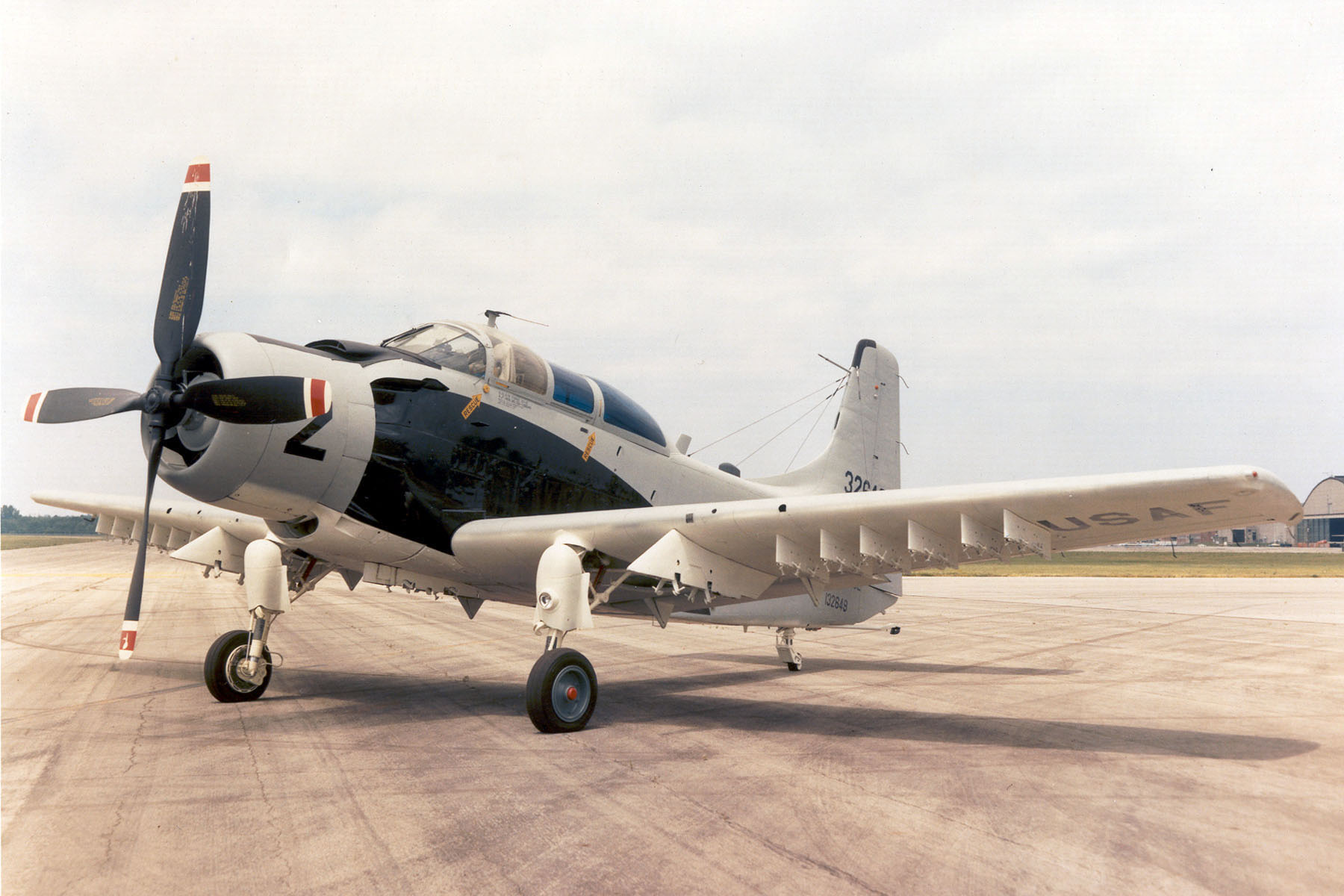
52-132649 is currently on display at the National Museum of the United States Air Force, Wright-Patterson AFB, Ohio. The runway was so littered with battle trash that Fisher had to abort his first approach. On his second try he stopped at the end of the strip and rolled back to Myers, peppered with small-arms fire all the way. “The enemy was so close,” Fisher noted, “I was afraid a couple of them might jump aboard my Skyraider before Myers could make it.” The prop wash from Fisher’s Spad blew Myers off the plane’s wing. Fisher throttled back to idle, dragged Myers headfirst into the side seat, then revved up and rolled, dodging debris to get airborne. They landed at Pleiku with 19 holes in the Skyraider. Fisher received the Medal of Honor for his heroics. His Skyraider is at the National Museum of the U.S. Air Force in Dayton, Ohio. Rescue missions sometimes turned into aerial combat. On Oct. 9, 1966, when a Navy Phantom went down 20 miles southwest of Hanoi, four Skyraiders of attack squadron VA-176 flew from USS Intrepid to provide cover for the rescue attempt. Four MiG-17s intervened. In the ensuing dogfight, the lead Spads scored one MiG damaged and another probable. Then Lt. j.g. Tom Patton, flying the No. 4 slot, saw that “a MiG darting along above the trees was heading in my direction, but its pilot didn’t see me.” Definitely seeing 20 mm tracers zipping past from Patton’s guns, the MiG pilot pulled up. “This was a fatal mistake on his part,” Patton recalled. “He was climbing, losing speed, while I still had plenty. Maybe his reversal would have worked against another MiG-17, but…I ended up at his six o’clock.” 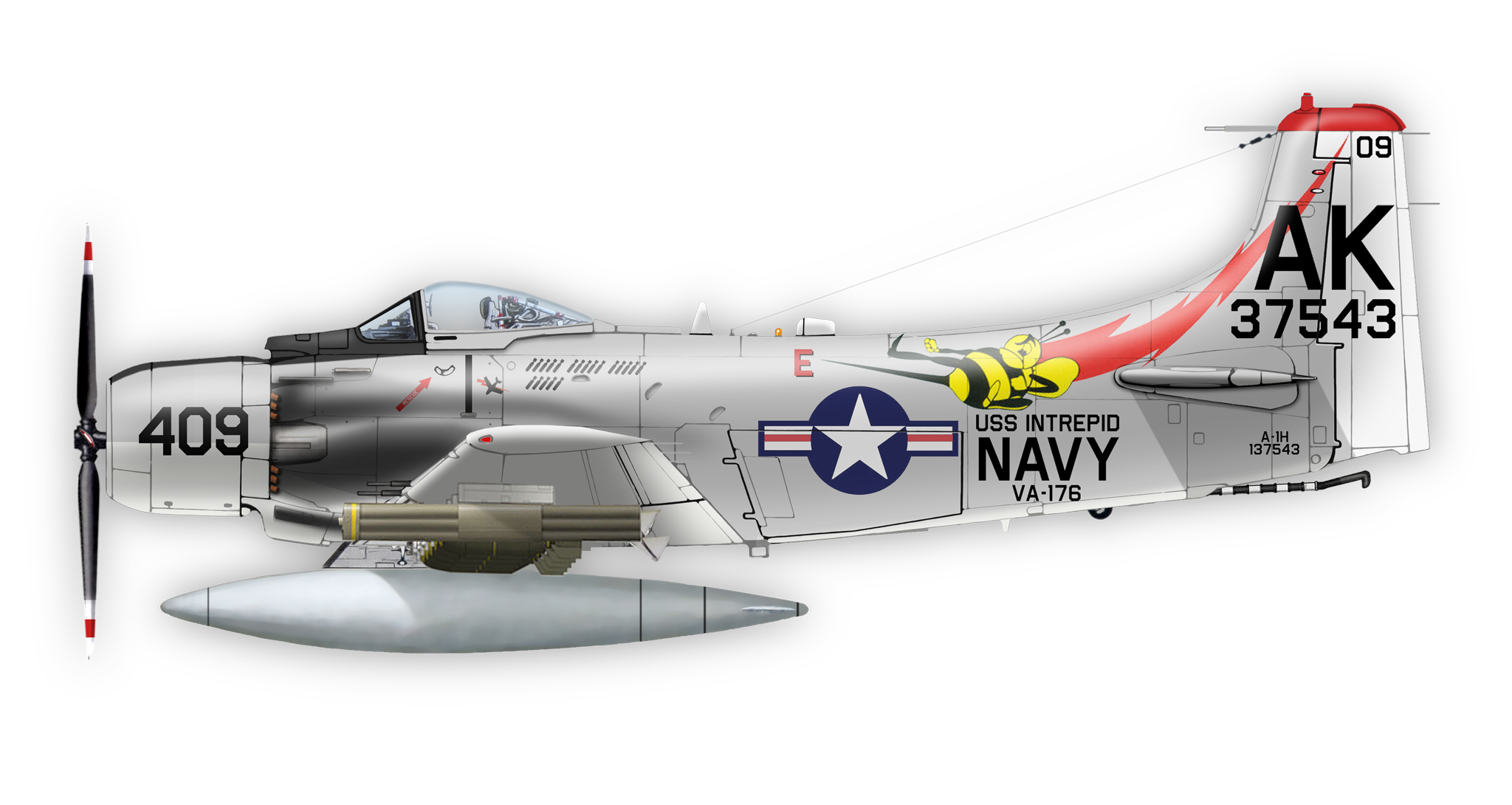
On October 9, 1966, while flying RESCAP over North Vietnam off the carrier USS Intrepid, four A-1 Skyraiders of VA-176 were jumped by four North Vietnamese MiG-17s. LTJG Tom Patton, flying Skyraider 409, scored one MiG 17 destroyed. Another was scored probable, and a third damaged. Patton stayed on the MiG’s tail, firing continuously. When his guns quit, he launched his 5-inch Zuni rockets. The MiG nosed over and plunged into the cloud deck. Patton saw the pilot eject. That was the last victory by a prop-driven fighter over a jet. Patton was awarded the Silver Star for his actions that day. 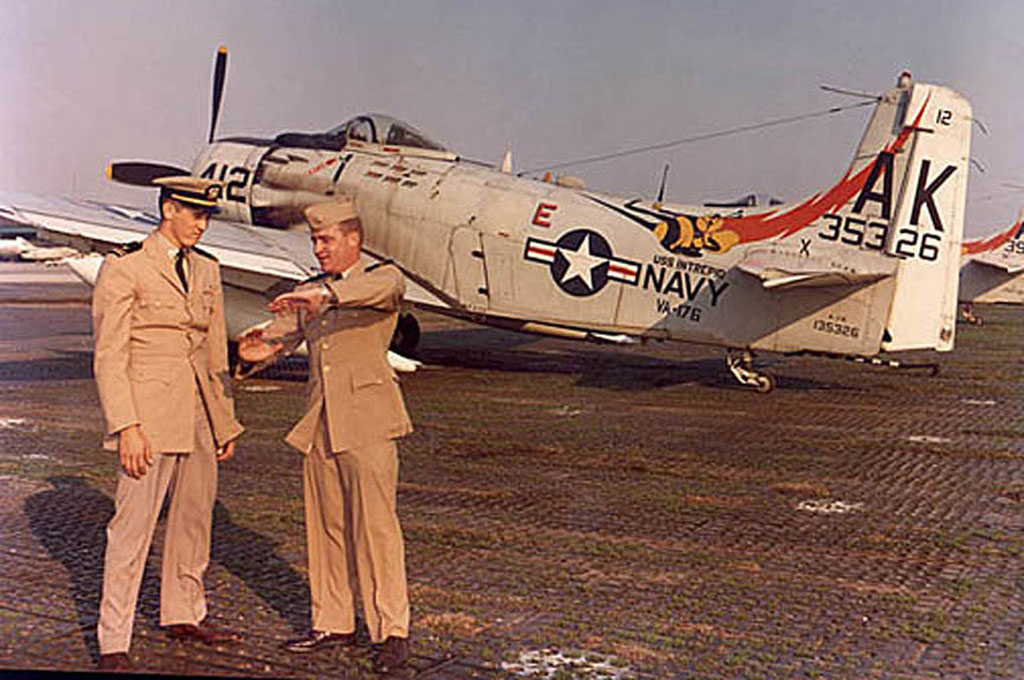
LtJg. Tom Patton (left), and Lt. Pete Russell discuss Patton’s maneuvers during the MiG engagement. In the end it wasn’t enemy MiGs but American jets that put an end to the Skyraider’s days as an attack aircraft. An expanding inventory of turbine-powered birds, including the Grumman A-6 Intruder and LTV A-7 Corsair II—both intended to replace the Spad—meant U.S. carriers needed tanks just for kerosene-based jet fuel and no longer had capacity for the aviation gasoline burned by the Skyraider. On Feb. 20, 1968, Lt. j.g. Ted Hill of VA-25 flew the Navy’s last A-1 attack mission, in support of U.S. Marines besieged at Khe Sanh. In April Hill flew that Spad from Naval Air Station Lemoore in California to the Naval Aviation Museum in Pensacola, Florida, where it resides today. The Navy handed the rest of its Skyraiders over to the U.S. and South Vietnamese air forces. 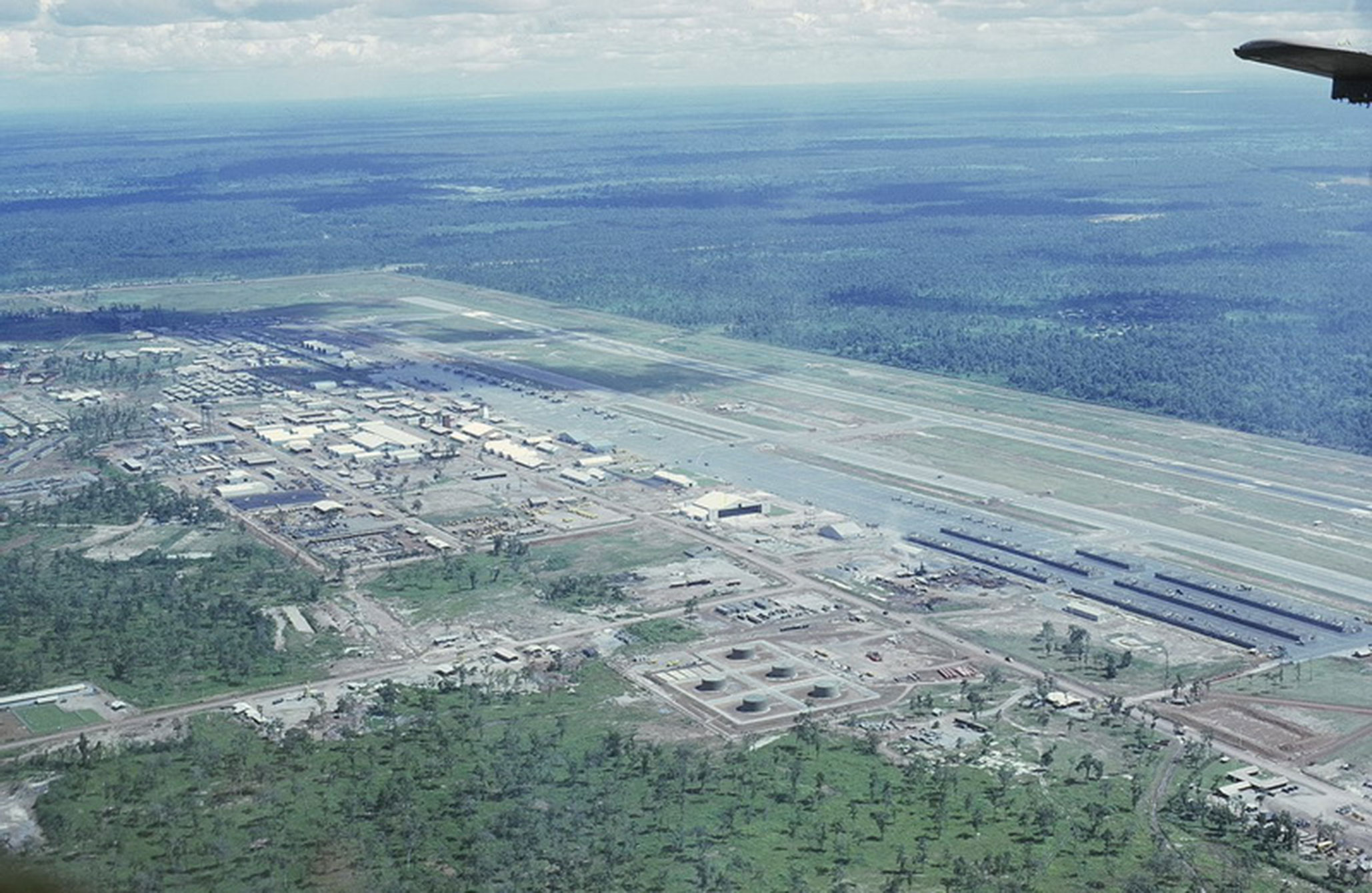
Naked Fanny Meanwhile in August 1967, the U.S. Air Force redesignated its air commando Skyraider units as special operations squadrons: the 1st SOS (call sign: Hobo); 602nd SOS (Firefly); and the 22nd SOS (Zorro), the Air Force’s last A-1unit. They flew from Nakhon Phanom Royal Thai Airbase in eastern Thailand and covered all of North and South Vietnam as guardian angels. One of the most reassuring sounds a downed American pilot could hear, besides the throb of a Sikorsky HH-3E “Jolly Green Giant” rescue chopper, was the radio call sign “Sandy” from an escort of weapons-laden, long-loitering Skyraiders flying rescue combat air patrol, or RESCAP. (All Skyraider pilots were designated “Sandy” when covering rescues.) VNAF A-1E Skyraiders mount air strikes, Nov. 1964 (Silent) USAF Skyraiders flying cover for “Jolly Green Giant” rescue helicopters performing search and rescue operations. Capt. John Flinn of the 1st SOS declared, “This rescue business is the best, most rewarding operation in the entire war. And if nothing else does, getting a man out makes sense. It’s really great to actually pluck a guy from the enemy after he’s been shot down.” In July 1969 Flinn, in Patton’s ex-Navy A-1H, was shot down over Laos and killed. 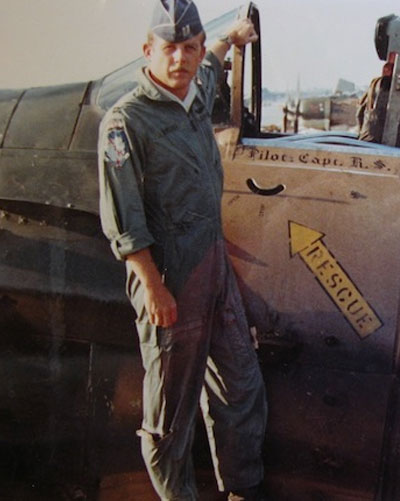
Capt. Richard S. Drury Skyraider pilots took a lot of ribbing from their fast-jet compatriots. A Spad jockey, it was said, could be recognized by his right leg, overdeveloped from standing on the rudder pedal against all that engine torque, and he had a greater chance of dying from slipping in an oil puddle than from an enemy bullet—but as one F-105 Thunderchief jock put it, “If a Sandy pilot walked into the bar, he would have a hard time paying for a drink.” On Sept. 1, 1968, the 602nd’s Lt. Col. William A. Jones III took charge of a rescue at Dong Hoi on the North Vietnamese coast. The downed Phantom’s back-seater had already been captured. The aircraft of the rescue force were seeking the injured pilot in the wrong place. Jones found him 8 miles away, covered by enemy 37 mm flak sites. “Trolling for fire”—going low and slow, daring enemy gunners to shoot and reveal themselves—was standard Spad procedure .Jones dueled with his 20 mm cannon and CBU-38 cluster bombs until his A-1H took a hit in the seat extractor. (Designed in the days before ejection seats, the Skyraider used the “Yankee” extractor system, a cockpit rocket that dragged the pilot out on a pair of straps.) Jones’ wingman called, “Get out! You’re on fire! Bail out now!” But the extractor wouldn’t launch. Beating down the flames, suffering second- and third-degree burns, Jones pulled the Spad skyward to transmit the downed pilot’s location until his radio burned out. “Col. Jones successfully landed his heavily damaged aircraft and passed the [downed pilot’s location] information to a debriefing officer while on the operating table,” reads his Medal of Honor citation. The Phantom pilot was saved. That November Jones died stateside in the crash of a private plane in Virginia. His Spad, The Proud American, was repaired, but on Sept. 22, 1972, it too went down over Laos, the last Skyraider combat loss of the war. 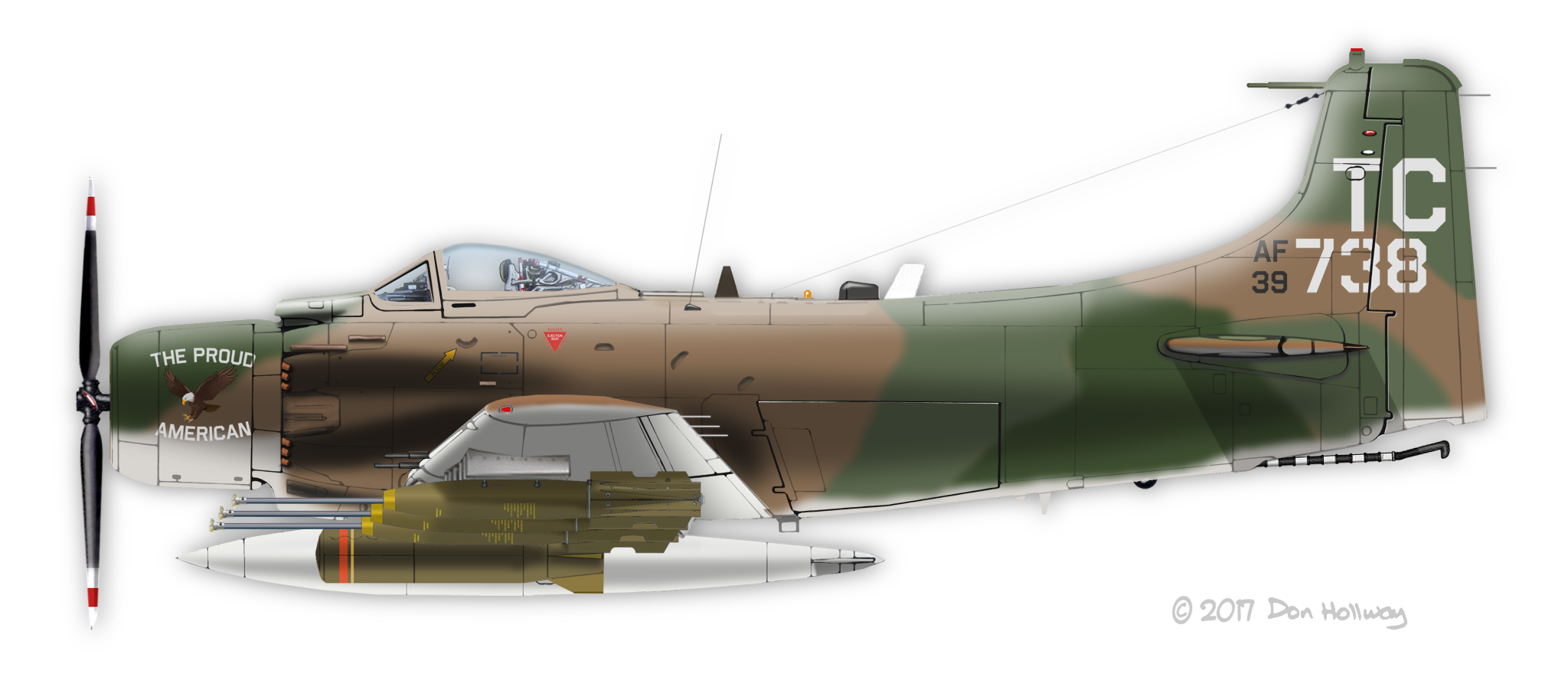
A-1H 52-139738, originally U.S. Navy AD-6 Skyraider Bu. No. 139738, authorized in 1952. 1st Special Operations Squadron, Nakhon Phanom RTAFB, Thailand, 1972. “Proud American” was flown by Lt. Col. William Jones of the 602nd SOS when he won the Medal of Honor on Sept. 1, 1968. Severely damaged, it was repaired, but on Sept. 28, 1972, it became the last Skyraider lost in the war, over northern Laos. Pilot 1Lt Lance Smith was rescued.
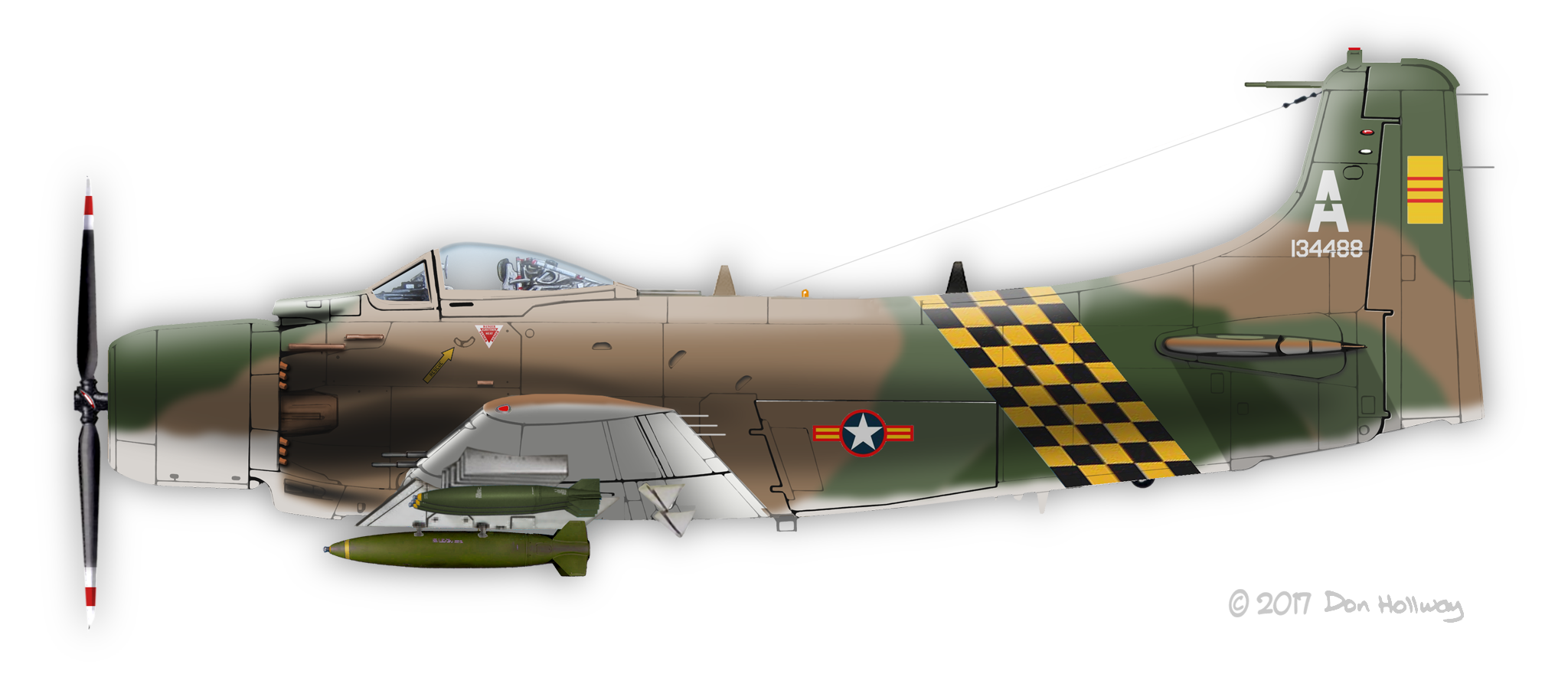
A-1H, 516th Fighter Squadron, Da Nang 1970. By this point in the war both the USAF and VNAF were using modern, low-drag bombs. #134488 was lost in October 1972. By then the U.S. was drawing down all forces in Vietnam. Air Force Spads flew their last mission on Nov. 7, keeping the enemy soldiers from the crash site of an Army UH-1 Iroquois “Huey” chopper near Quang Tri until seven survivors were rescued. In 1973 the Air Force handed its remaining Spads over to the South Vietnamese. They would take part in the last-ditch fighting during the North’s 1975 Spring Offensive, which ended in the Communist capture of Saigon. 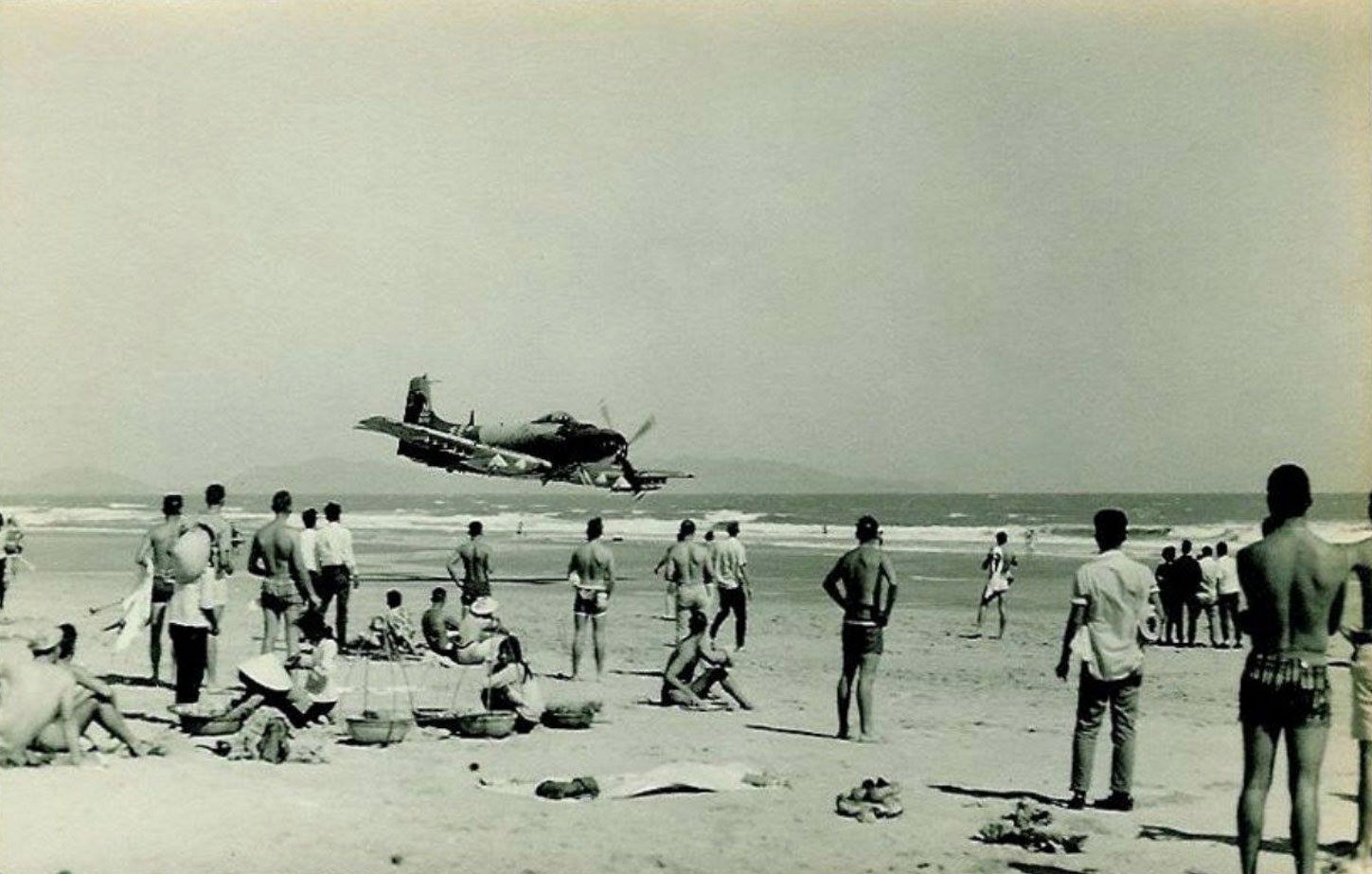
An unknown VNAF Skyraider pilot buzzes the beach at Vung Tau, Dec. 1967. On April 5, 1975, Nguyen Lanh, a first lieutenant in the 518th Fighter Squadron at Da Nang, was briefed that the NVA had crossed the DMZ in division strength, headed for a bridge over the Thach Han River to invade South Vietnam. Each Skyraider carried 12 500-pound bombs. Shooting up the tank columns and blowing the bridge, they forced the invaders to seek another crossing further inland. Over the course of the next week, Lanh was credited with knocking out 17 North Vietnamese tanks. Although Skyraider pilots near the DMZ were having some success, they were far removed from their headquarters in Saigon and didn’t “know the whole story on how bad the war was going for us,” recalled Maj. Ho Van Hien of the 514th Fighter Squadron. On a 150-mile flight from Phan Rang Air Base southwest to the capital, his Spad hauled more refugees than bombs. “I flew back to Bien Hoa [Air Base outside Saigon] with 25 people in the back of my A-1E,” he said. As the fighting closed in, the 514th withdrew from Bien Hoa across the city to Tan Son Nhut and, when that became untenable, to Bien Thuy in the far south. “Columns of smoke were rising up from various parts of Saigon following indiscriminate NVA mortar attacks,” noted Lt. Thai Ngoc Van, who flew a Spad in South Vietnam’s last stand on April 29. “We spent quite a long time over the target area, working with ARVN troops that were trying to hold their positions against a considerably larger NVA force that was advancing on Saigon. We spent all the remaining bombs and cannon rounds before heading back to Bien Thuy.” Last flight of VNAF AC-119K. NBC’s Don Harris reports from Saigon on the morning of April 29, 1975. Enlarge 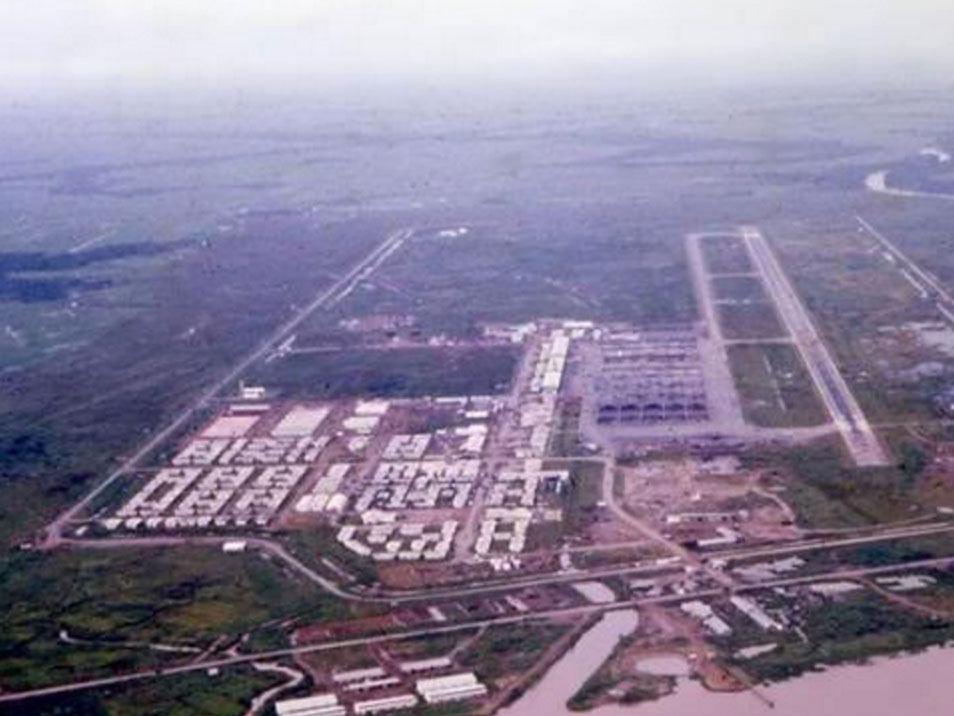
Binh Thuy Air Base, the southernmost VNAF/USAF airbase of the war. VNAF Skyraiders made their last escape to Thailand from here. Like many other South Vietnamese pilots, Hien escaped to U-Tapao, Thailand, with another two dozen refugees stuffed into the A-1E. “We were disappointed to see American soldiers with their guns leveled meeting us on the ramp,” he recalled. The Americans quickly applied U.S. insignia on the Skyraiders to cover South Vietnamese air force markings. “They took our weapons and all of our flying gear,” Hien said. “We were devastated.” More than 40 years later, an A-1 painted in a semblance of U.S. Air Force colors is on display at the War Remnants Museum in Ho Chi Minh City, and two others are at a military history museum in Hanoi. In all, 144 Skyraider pilots and 266 planes were lost in Vietnam, most from ground fire, but five were downed by surface-to-air missiles and three fell in air-to-air combat, including two struck by MiGs. Today only about 50 Skyraiders survive. “We were flying anachronisms,” said former B-52 and A-1 aviator Drury, “piloting Spads through a supersonic world, tasting the thunderstorms at 8,000 feet when an SR-71 [supersonic spy plane] was hitting three times the speed of sound above 70,000 feet. It was a ludicrous situation but one I applauded….Some of the greatest and most dangerous and heroic flying ever done was right there…in old A-1 Skyraiders.” 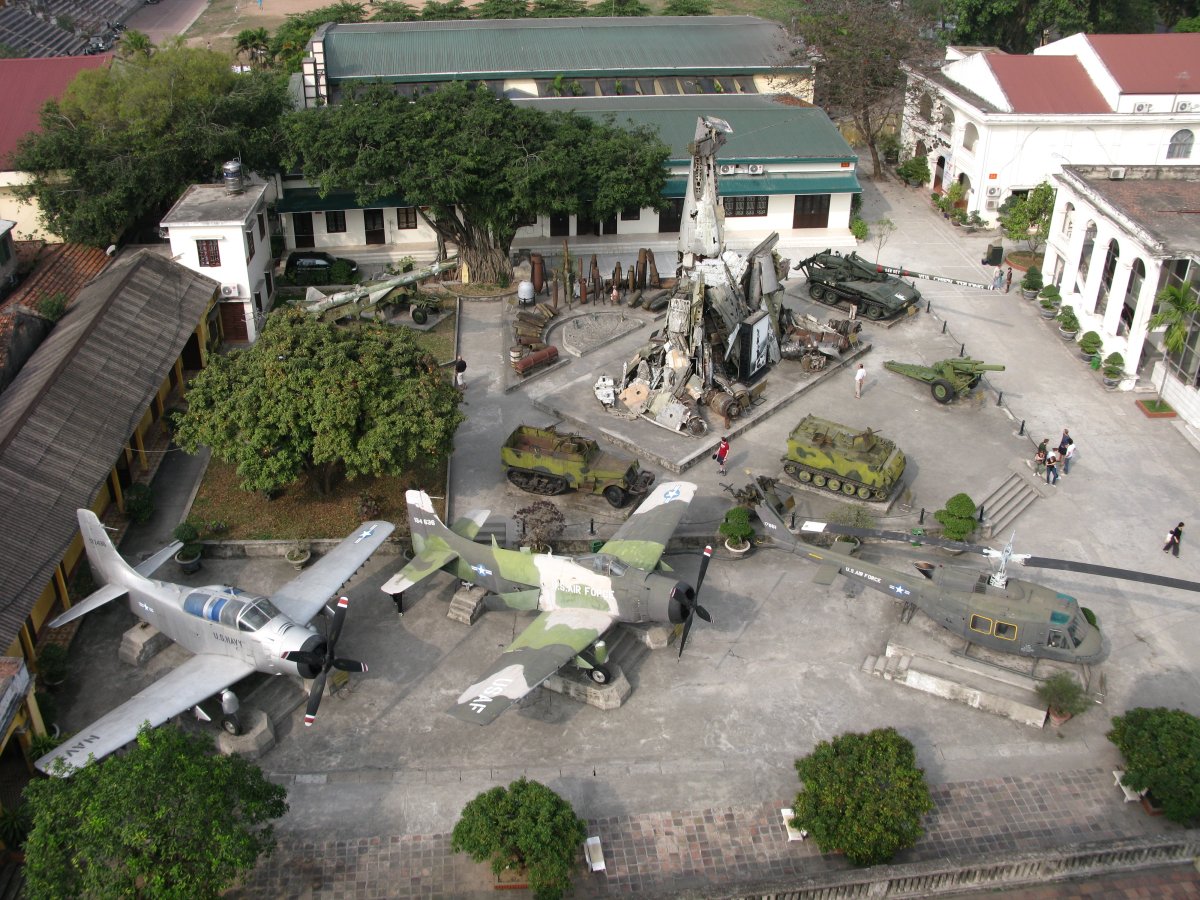
A-1E (132436) and A-1H (134636) Skyraiders, among others, at the Vietnam Military History Museum, Hanoi Bibliography
Burgess, Richard R., and Rosario Rausa. US Navy A-1 Skyraider Units of the Vietnam War. Oxford: New York, NY: Osprey, 2009. ISBN 9781846034107 About the authorAuthor/illustrator/historian Don Hollway has been published in Aviation History, Excellence, History Magazine, Military Heritage, Military History, Civil War Quarterly, Muzzleloader, Porsche Panorama, Renaissance Magazine, Scientific American, Vietnam, Wild West, and World War II magazines. His work is also available in paperback, hardcover and across the internet, a number of which rank extremely high in global search rankings. More from Don Hollway:
|
